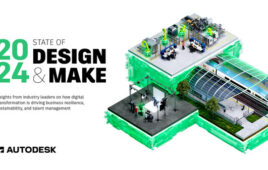(Temecula, CA)– Opto 22 has announced the release of PAC Project™ version 8.1, the company’s flagship automation software suite that includes control programming, HMI development, OPC connectivity, and enterprise database integration. This latest version features new distributed control functions and support for several new hardware offerings.
The new PAC Project 8.1—part of Opto 22’s SNAP PAC System—is unique among PAC-based control systems because it offers an architecture where control functions like analog scaling, digital counting, and PID loop control are distributed to local I/O processors.
New functions for PAC Project 8.1’s PAC Control include:
• Frequency measurement—for determining the frequency of digital states and often used to read the speed of rotating machinery, velocity encoders, etc.
• Period measurement— for determining how long a digital point remains on or off, which is useful for measuring the period of a slow shaft rotation, for example.
• Analog totalization—for sampling and totaling analog input readings at predetermined intervals; frequently used to record flow totals in pipelines.
• Digital totalization—for determining the total on-time or off-time of a digital input; commonly used to record machinery on-time for maintenance purposes.

These functions augment existing SNAP PAC System distributed I/O functions such as digital counting, latching, analog clamping, alarming, event reactions, pulse and waveform generation, and analog ramping. Moreover, all of these commands execute at the I/O brain level—off-loading these time-sensitive tasks from the programmable automation controller (PAC) and significantly reducing I/O network traffic.
Upgrades to PAC Project:
• A new security feature provides user login and logout for capturing operator actions during runtime (an important consideration for companies that must comply with U.S. FDA 21 CFR Part 11 guidelines).
• New runtime features reveal the origins of controller and I/O data, improving development and commissioning of new HMI screens.
• New multimedia alarming capabilities associate and play unique sound files with individual alarm notifications and acknowledgements.
• Support for 64-bit integer tables allows the exchange of large data arrays with the PAC controller.
PAC Project 8.1 also supports Opto 22’s latest control hardware: new SNAP PAC Serial I/O brains (the SNAP-PAC-SB1 and SNAP-PAC-SB2); a new standalone programmable automation controller (SNAP-PAC-S2); and new 8-channel analog input modules (SNAP-AIV-8, SNAP-AIMA-8, and SNAP-AICTD-8). Details of these recent hardware releases are covered separately.
Also new is support for concurrent serial and Ethernet I/O networking. All PAC Project commands and functions apply equally to SNAP PAC Serial and SNAP PAC Ethernet I/O brains, reducing system design and development time. For example, a single motor control routine or HMI screen can be developed using either serial- or Ethernet-based I/O, eliminating the need to choose a network before application development begins.
Roster of PAC Project components:
• PAC Control—an intuitive flowchart and scripting control programming software for developing control strategies that run on SNAP PAC controllers, and ideal for sequential control, batch and process control, motion control, complex math, conditional branching, string handling, subroutines, PID loop control, and more.
• PAC Display—a Microsoft® Windows®-based human-machine interface (HMI) development application used to create graphical interfaces that mimic a process. Support for alarm management, recipe handling, operator logging, real-time and historical trending, multimedia, and unlimited tags puts PAC Display on par with competing HMI development applications costing thousands of dollars more per seat.
• PAC Manager—a configuration and maintenance tool used to inspect and view control strategy variables and I/O data in real time.
• OptoOPCServer™ (included with PAC Project Professional or available separately)—an OLE for Process Control (OPC) 2.0-compliant server used to consolidate and publish SNAP PAC System data to OPC-aware clients, including third-party HMIs such as Wonderware’s InTouch®, Intellution’s iFix®, and Iconic’s Genesis®.
• OptoDataLink™ (included with PAC Project Professional or available separately)—connectivity software used to enable bidirectional data transfer between the SNAP PAC System and enterprise databases—such as Microsoft SQL Server, Microsoft Access, and MySQL—without brokering the data through an HMI.
Opto22
www.opto22.com
:: Design World ::
Filed Under: AUTOMATION, CONNECTIVITY • fieldbuses • networks, ENGINEERING SOFTWARE





Tell Us What You Think!